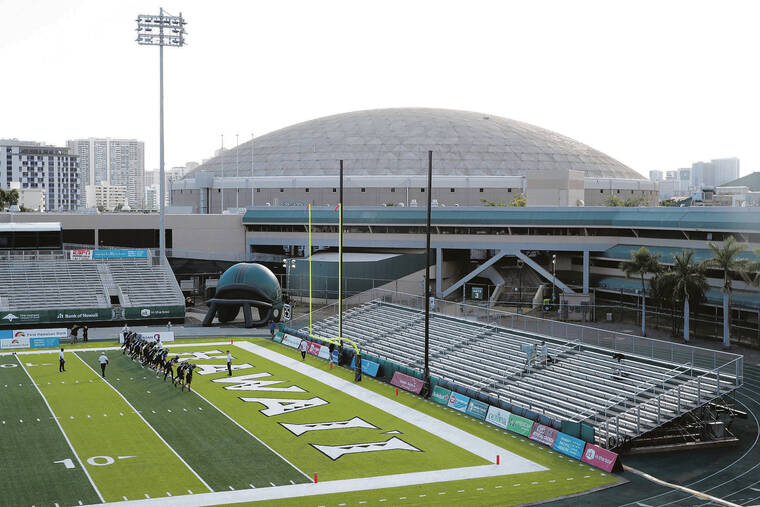Parents of University of Hawaii football players expressed disappointment Tuesday after learning they still won’t be allowed to attend their sons’ home games until further notice, as UH remains the only one of 130 major college football teams in the country to not host fans.
“It is super-disheartening,” said Beth Adams, mother of freshman offensive lineman Nate Adams.
Parents of at least 10 players were involved in composing and approving an email sent to Gov. David Ige on Monday, requesting an exception to the current 28-day order limiting outdoor gatherings to 25 people and those indoors to 10.
The order, which went into effect Aug. 25 because of spikes in COVID-19 cases, hospitalizations and deaths due largely to the virus’ delta variant, could be halted or extended for another 28 days next week.
Ige rejected the proposal from the parents that asked for 500 vaccinated, masked and socially distanced fans to be allowed at the 9,000-seat outdoor Clarence T.C. Ching Athletic Complex for Saturday’s game against San Jose State. A subsequent email from Scott Schager, father of freshman quarterback Brayden Schager, suggested an even smaller number of fans, but that also did not receive the governor’s approval.
“I hope we will be in a better place before the end of the football season,” Ige said Tuesday in response to the email. “However, at this point, this type of activity is simply not safe.”
The governor said he understands UH athletics are important to the community, but that health care resources are still stretched dangerously thin.
“Our hospital ICU units are at maximum capacity. Any significant increase in ICU patients could put our healthcare system over the threshold,” he said.
The Warriors, who also played in an empty stadium Sept. 4 against Portland State in the home opener, haven’t performed in front of a home crowd since the Dec. 24, 2019, Hawaii Bowl at Aloha Stadium.
UH athletic director David Matlin had also proposed last week that 150 spectators be allowed at the 10,000-
seat SimpliFi Arena at the Stan Sheriff Center for Rainbow Wahine volleyball matches and 250 at the outdoor Waipio Peninsula Soccer Stadium, which has capacity for 4,500.
“I am disappointed with the governor’s decision to deny any fan attendance at this week’s UH sporting events,” Matlin said. “We believe that the plans we have proposed to allow a very limited number of fans, all of whom would be required to be fully vaccinated, masked, and socially distanced, would allow for a safe and responsible event similar to many other permitted activities. It is my hope that the infection numbers will continue to go down in our community, that hospital saturation will return to safer levels, and that we will be allowed to welcome back our loyal fans very shortly.”
Matlin estimated last spring that each of UH’s six football games at the Ching Complex would bring in around $570,000 in ticket and other revenue, such as concessions and parking.
Adams and her husband, Kevin, and daughter, Emylea, Nate’s father and sister, had planned on attending several games in Hawaii this fall. Other UH football parents from the mainland came for the Sept. 4 game but were told to leave UH’s lower campus, where the football stadium is.
Some parents have lost money because of airline ticket cancellations.
“It’s terrible to say, but there’s no point in it if we can’t go to the game,” said Beth Adams, who added that their family, which lives in Dallas, will see Nate at some road games instead. “No matter how big they are, they’re our children. And we don’t want them to be alone. They need to feel our love and support. They’ve had a rocky start (1-2 after Saturday’s loss at Oregon State), so they need it even more. They all need to feel that support.”
Families that live in Hawaii have been affected financially, too.
“Some of us cannot afford to keep going to all the road games,” said John Panoke, father of sophomore receiver Jonah Panoke. “If I had a chance to talk to the governor or mayor, I’d tell them to please reconsider, because I think it would boost the morale when our kids can look in the stands and say, ‘Wow, our parents finally get to see us play.’”
Several people told the Honolulu Star-Advertiser they have seen groups of spectators much larger than 25 at youth soccer games at Waipio and other parks this month.
“I’ve seen it myself, any Saturday or Sunday. The parking lot is full. Tents, no social distancing,” Panoke said. “We’re not saying we don’t want the kids to play soccer, but we just want it to be fair.”

